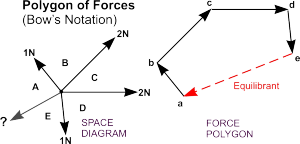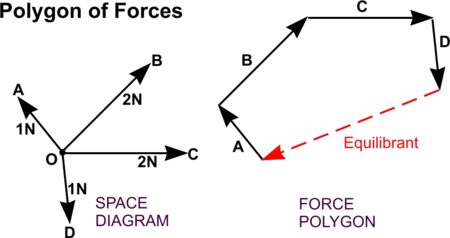Force diagrams notation bow polygon bows
Table of Contents
Table of Contents
If you are studying physics or engineering, you have probably heard about the term “force polygon”. However, many people find it challenging to understand how to draw force polygons. This post will guide you through the process of drawing force polygons step-by-step, so you can master this important concept!
When it comes to how to draw force polygons, students often struggle with understanding the concept of resolving forces. This concept refers to breaking the forces into their components, so they can be easily represented in a diagram. Another challenge that students face is understanding how to combine these components to create the force polygon. Additionally, it can be tough to visualize how to draw the polygon in different scenarios, as it requires a lot of precision and attention to detail.
Here are the basic steps to follow when learning how to draw force polygons:
Step 1: Identify the Forces Acting on the Body
The first step is to identify all of the forces acting on the body in question. These may be external or internal forces, and they may be acting in different directions. After you have identified all of the forces, make a list of their magnitudes and directions.
Step 2: Resolve the Forces
The next step is to resolve the forces into their components. This is done by using trigonometry to determine the horizontal and vertical components of each force. Once this is done, you can redraw the diagram to reflect the resolved components.
Step 3: Draw the Force Polygon
After you have resolved the forces, you can then draw the force polygon. To do this, draw a line to represent the first force, making sure to label it with the force’s magnitude and direction. Then, draw a line to represent the second force, making sure that the start of this line is at the end of the first force. Continue this process for all of the remaining forces. Once you have finished, the last line should end at the start of the first line, forming a closed polygon.
Step 4: Analyze the Results
After the force polygon has been drawn, you can then analyze the results to determine the net force acting on the body. To do this, measure the length of the vector that starts at the beginning of the first line and ends at the end of the last line. This vector represents the net force acting on the body, and its magnitude and direction can be calculated using trigonometry.
The Importance of How to Draw Force Polygon
It is essential to understand how to draw force polygons because they are an essential tool for understanding how different forces interact with each other. They can be used to predict the motion of objects and to analyze the stability of structures. By mastering this concept, you will be able to solve complex physics and engineering problems with ease.
Real-Life Example of How to Draw Force Polygon
Let’s say that you are trying to determine the net force acting on a book that is resting on a table. The book has a weight of 10 Newtons, and there are two forces acting on it: a force of 5 Newtons pushing it to the left and a force of 8 Newtons pushing it to the right. We can begin the process of drawing the force polygon by first resolving the two forces into their components. We can then draw the force polygon as described in Step 3 of the above section. Finally, we can analyze the results to determine that the net force acting on the book is 3 Newtons to the right.
Common Mistakes to Avoid When Drawing a Force Polygon
One common mistake that students make is forgetting to resolve the forces into their components. It is essential to do this step correctly; otherwise, the force polygon will not accurately represent the forces acting on the body. Another mistake is not drawing the polygon accurately. Even a small error can result in an incorrect analysis of the results. Finally, it is important to remember to label all of the forces and their components clearly, so you won’t lose track of them.
Question and Answer
Q: What is a force polygon?
A: A force polygon is a graphical representation of multiple forces acting on a body, drawn to scale, and used to determine the net force acting on the body.
Q: Why is force polygon important?
A: Force polygons are used to predict the motion of objects and to analyze the stability of structures. They are an essential tool for understanding how different forces interact with each other.
Q: What is a common mistake to avoid when drawing a force polygon?
A: Forgetting to resolve the forces into their components is a common mistake. It is crucial to do this step correctly, or the force polygon will not accurately represent the forces acting on the body.
Q: Can force polygon be used in real-life scenarios?
A: Yes, force polygons can be used in real-life scenarios, such as predicting the motion of objects or analyzing the stability of structures.
Conclusion of How to Draw force Polygon
Drawing force polygons is an essential tool for understanding how different forces interact with each other. By following the steps outlined in this post and avoiding common mistakes, you can master this concept and use it to solve complex physics and engineering problems with ease. With practice, you will be able to draw accurate force polygons that will help you analyze the forces acting on any body or structure.
Gallery
Force Diagrams - DT Online

Photo Credit by: bing.com / force diagrams notation bow polygon bows
Force Diagrams - DT Online

Photo Credit by: bing.com / polygon
Solved 5. Calculate The Resultant Of The Forces Shown Below | Chegg.com
Photo Credit by: bing.com / polygon resultant solved problem graphical calculate transcribed
Solved Use Polygon Method To Draw The Resultant Vector R = A | Chegg.com

Photo Credit by: bing.com / draw polygon resultant vector method use solved chegg figure force transcribed problem text been answers questions
Draw Forces Of Polygon, Law Of Polygon Of Forces, Assignment Help

Photo Credit by: bing.com / polygon forces draw law solution assignment help figure







